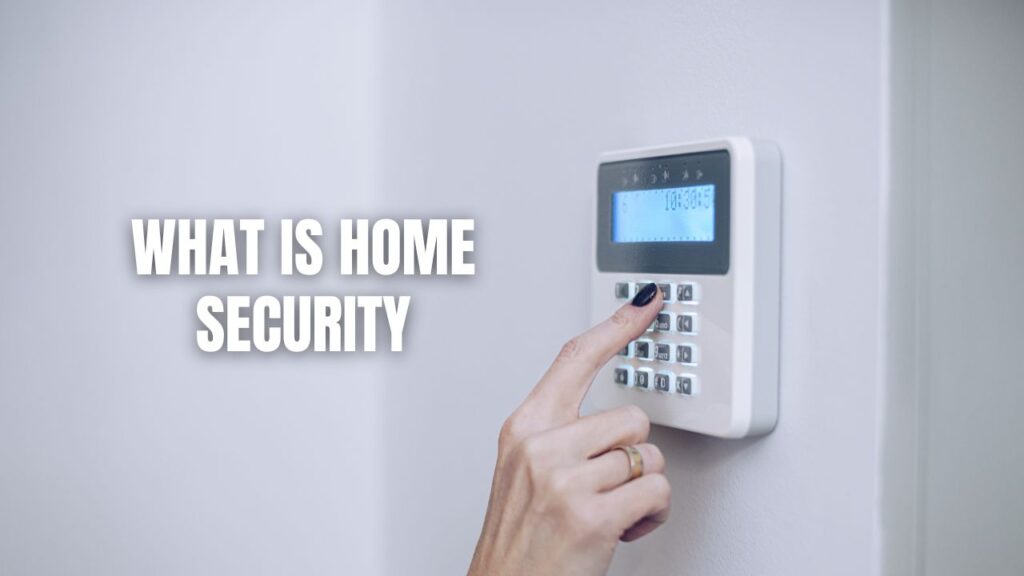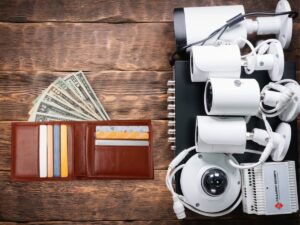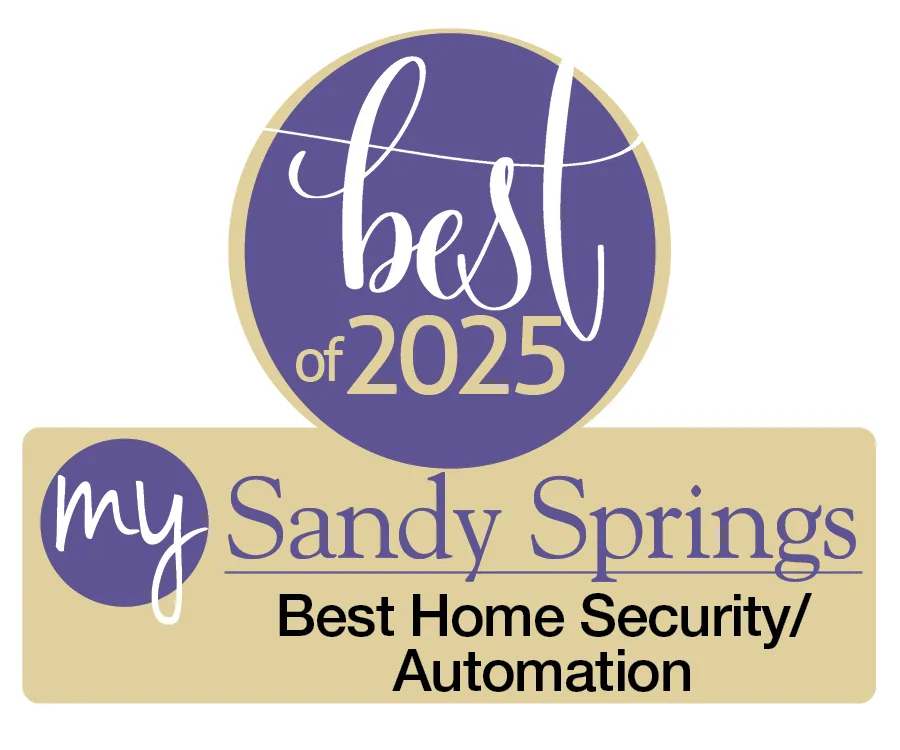Home security involves practices and systems to help secure your home from intruders and damage. A home security system may include features like security cameras, sensors, alarms, smart locks, monitoring capabilities, and integration with other smart home devices. The goal of a home security system is to deter potential intruders, detect break-ins, and provide alerts so action can be taken when security breaches do occur.
Why Is Home Security Important?
Security should be a major concern for homeowners for a few key reasons:
Safety: Ensuring doors are locked, alarms are enabled, and motion sensors are functioning properly promotes safety from intruders. Burglaries in the United States predominantly involve forcible entry, so taking measures to secure all access points helps prevent unauthorized access.
Peace of Mind: Having a monitoring system in place that can detect and alert to threats gives household members assurance even when away. Features like security cameras provide visibility and evidence if needed.
Loss Prevention: An average burglary in the United States lasts only a few minutes, but has a median loss value of $1,300. Having effective security measures can cut down response time and minimize losses.
Insurance Discounts: Many insurance companies offer premium discounts for professionally monitored security systems. Having a security system may reduce rates 5-20% or more.
What Does a Home Security System Include?
Home security systems can vary greatly depending on provider, equipment, features, and cost. But most systems are built around a few key components:
Security Panel
Also known as a control panel, this is the brain of the system. It communicates with sensors and devices throughout the home, activates alarms, receives commands from remote controls and mobile apps, and communicates with monitoring centers.
Motion Sensors
Motion detectors use infrared heat and motion sensing capabilities to detect when an intruder enters an area. They transmit alerts to the control panel to activate other security protocols.
Door/Window Sensors
As the name suggests, these battery-powered sensors are installed on entry points throughout the home. If a door or window is opened, or glass is broken, an alert is triggered.
Security Cameras
Indoor and outdoor security cameras provide visual monitoring capabilities. Features like night vision, real-time alerts, cloud storage, and HD video give eyes on potential threats.
Alarm Siren
When the security system detects an intruder through sensors or cameras, the installed alarm systems activate loud audible alarms and bright strobe light effects. This deters intruders and draws attention.
Monitoring Center
Professionally installed and monitored security systems will route alerts to an offsite monitoring center. Here, staff can view sensor activity and cameras, confirm if threats exist, notify first responders if needed, and contact homeowners.
Smart Home Integration
Many modern security panels integrate with popular smart home platforms. This allows you to arm, disarm, monitor, and control your security system remotely from smartphones, tablets, computers, and smart speakers/displays.

What Are the Different Types of Security Systems?
From DIY kits to advanced smart home setups, home security systems come in many shapes and sizes. Here are the most common setups available:
Self-Monitored
Self-monitored security systems offer key security without monthly fees. Installation is DIY or through a technician. Alerts route to an app for remote arming, disarming, notifications, and access to security camera feeds. There is no monitoring center.
Professionally Monitored
For a monthly fee, alerts also route to an offsite monitoring center in addition to mobile apps and other designated contacts. Monitoring center staff can view cameras, confirm threats, notify first responders, and contact homeowners as needed.
Smart Home Security
Smart security systems integrate with popular platforms like Amazon Alexa, Google Assistant, Apple HomeKit, IFTTT, and more. Features can include voice commands, automation based on modes or triggers, centralized control of other smart devices, and remote access.
Wired vs Wireless
Traditional security systems route everything through wired connections back to a central panel. Wireless security uses radio frequency and cellular signals to communicate wirelessly for more flexible installation. Wireless systems often rely more heavily on battery power.
DIY vs Professional Install
DIY kits provide equipment for self-installation by the homeowner. Professional installation services will assess the home, recommend equipment, perform the installation, test functionality, register the system, and provide product education.
Main Components of a Home Security System
While actual security system components can vary greatly, most setups include some assortment of the following:
Control Panel – The central device that communicates with security sensors and devices throughout the home. Often wall-mounted.
Keypad – A control panel for arming/disarming the system or triggering modes, events, and alerts. Sometimes built into the main panel.
Motion Sensors – Detect intruder movement throughout the home, triggering alerts to the control panel.
Door/Window Sensors – Detect when doors/windows are opened and closed. Alert when opened without being disarmed first.
Glass Break Sensors – Specialized acoustic sensors that respond to certain noise frequencies that occur when glass breaks.
Smoke/Heat/Freeze Sensors – Monitor environmental threats like fire and extreme cold. Integrate with security system for alerts.
IP Security Cameras – Provide live video feed accessible remotely via browsers and mobile apps. Features may include motion-detection, night vision, HD video, etc.
Alarm Siren – Loud audible siren and bright strobe lighting activated when threats are detected while the system is armed. Deterrent for burglars.
Smart Locks – Keyless electronic locks operated via apps, codes, biometrics, or other smart integration. Lock/unlock status is communicated to control panel.
Flood Sensors – Detect presence of water where it shouldn’t be. Help protect against water damage when appliances, pipes, or weather events cause flooding.
Smart Home Integration – Popular platforms like Alexa, Google Assistant, Apple HomeKit, IFTTT, and others may have integration capabilities with security systems. Enables features like voice commands, automation, and centralized control.
What Are the Benefits of a Home Security System?
Home security systems, especially professionally installed and monitored setups, provide many benefits for homeowners:
Burglary Deterrent – Security signage alone is sometimes enough to deter opportunistic burglars. The threat of sirens, cameras, and quick police response also provide strong incentives for burglars to avoid homes with security.
Loss Prevention – Security features like door/window sensors, motion detectors, smoke detectors, flood sensors, and more can all detect threats early to prevent incidents from becoming catastrophic losses.
Peace of Mind – Knowing your home and family members are protected even when away offers comfort and confidence. Features like remote access to cameras and alerts aids this.
Insurance Discounts – Many insurance companies offer premium discounts for professionally monitored security systems. This is due to the reduced risk these systems provide. Discounts generally range from 5% to 20%.
Convenience – Features like smart locks, cameras, automation, and mobile access all lend added convenience to managing your home on the go.
Market Value – Homes listing security systems as an included feature tend to sell for 3-5% more on average compared to comparable listings without security systems.
What Are Common Smart Home Security Features?
Smart home platforms and individual security devices now include advanced AI and automation features to expand capabilities even further:
Facial Recognition – Smart security cameras can use advanced facial recognition algorithms to distinguish known household/family members from strangers when capturing video and images. Unique faces can trigger customized alerts and response actions.
Anomaly Detection – AI in cameras and sensors can also detect anomalies and respond accordingly. Examples include unusual motion at odd hours, unknown vehicles parked nearby, furniture/objects that are out of place or missing, etc.
Automated Alert Sequences – Systems can activate multiple notifications, alerts, sirens, camera captures, door locks, lighting effects, thermostat adjustments, and other actions automatically based on trigger events from sensors and detectors.
Personalized Modes/Routines – Custom home modes can be activated manually or automatically to alter system behavior accordingly.Sleep, away, vacation, and party modes are common.
Location-Based Triggering – Using homeowner location data from smartphones, sensors equipped to detect nearby presence, and geo-fencing; modes, alerts, cameras, and actions can activate based on everyone’s location.
Video Verification – When alarms are triggered, professional monitoring centers can access on-demand live video feeds from throughout the home to visually verify threats and determine response needed.
Smart Speaker Integration – Controlling security systems via voice through smart speakers by leveraging platforms like Amazon Alexa, Google Assistant, and Siri Shortcuts.
What Are the Main Security Concerns When Securing a Home?
While security considerations are unique for every home, most residential security concerns revolve around these areas:
Entry Points – Since burglars exploit openings to illegally enter homes, properly securing all exterior doors and windows should be the top priority. Usage of smart locks, door/window sensors, glass break sensors, and security cameras covering these vulnerable access points is key.
Isolation – Homes in isolated areas typically have delayed police response, making effective alarms, deterrents, and visual verification of breaches through security camera monitoring much more crucial.
Occupancy – Homes left vacant for extended periods are inviting targets for patient and observant burglars. Making a residence look occupied or having a house sitter during vacations is helpful. Remote visibility via cameras aids monitoring when away.
High-Value Items – Luxury items, cash, firearms, jewelry, collectibles, prescription medications, and small valuables popular with thieves should be properly stored in locked containers or secure rooms to limit access during break-ins.
Environmental Triggers – Severe weather events, failing appliances, aging infrastructure, nearby construction blasting, natural disasters, and other environmental threats can trigger property damage, fires, flooding, and more if not properly monitored.
Repeat Victimization – Homes burglarized even once have much higher likelihood of being targeted again in the future. Enhancing security measures following initial victimization is imperative.
What Are Some Home Security Best Practices?
Aside from installing and properly maintaining security systems, homeowners should adopt these basic practices:
Lock All Doors/Windows – First line of defense is properly securing all exterior access points, even upper floor windows sometimes forgotten. Get in habit of checking locks nightly.
Close Blinds/Curtains – Don’t allow direct view of high-value items. Make it look like someone is home. Glass break sensors still detect when glass breaks even if covered.
Leave Some Lights On – Maintain appearances that someone is home. Smart bulbs on timers/motion detectors lend added realism thieves may buy into.
Install Cameras Properly – Position security cameras to cover approaches, access points, high-value areas, and as much of perimeter as possible. Avoid creating blind spots.
Trim Landscaping – Shrubs, vegetation, fencing, yard decorations, firewood, ladders, and sheds near the home should not provide concealment/climbing assist for intruders.
Reinforce Entry Points – Beyond locks and sensors, all exterior doors should have strong frames, high-security strike plates, and three-inch screws securing hinges to studs.
Display Security Signage – Signs indicating alarms and camera surveillance systems in use create ample deterrence even if systems don’t exist. Many false signs exist.
Make Residence Look Occupied – When vacant for stretches, use smart lighting schedules, a TV left on timers, vehicle/driveway activity detections to simulate normal occupancy behaviors criminals seek to exploit.
Final Thoughts
Property crime and burglary numbers may fluctuate year to year, but the threat to homeowners persists if proper security precautions are not followed. Taking measures to harden the security of your home, adding layers of surveillance and detection, maintaining diligence on the small but meaningful habits that express active occupancy, and expanding capabilities through modern smart home integration each build substantial risk reduction.
With smart home technology evolutions happening at amazing speed complementing reliable old-school physical security tactics, homeowners have an expanding array of home security options at multiple budget levels. Avoiding the devastating financial, emotional and psychological impacts of home burglary and theft is readily achievable through proper research, planning, installation, and maintenance of home security systems.
The innovations show no signs of slowing down, with AI augmentation, expanded automation, and Internet of Things connectivity bringing added intelligence and user control to the forefront. All signs point to the home security sector accelerating advancements for many years to come as risks, technology possibilities, and cost-benefit awareness all continue to rise over time.
Contact Callaway Security™ to enhance you home security!












